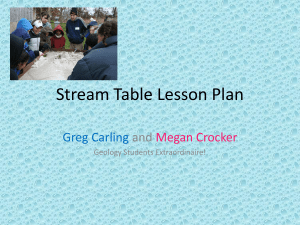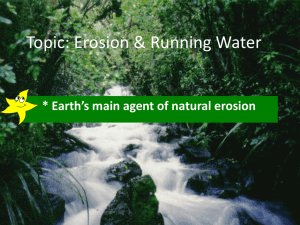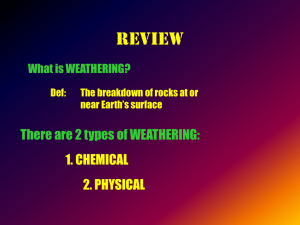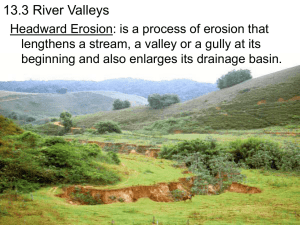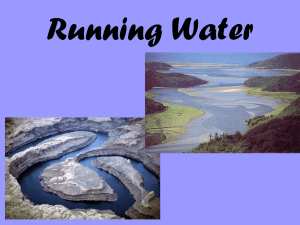Rivers & Streams
advertisement
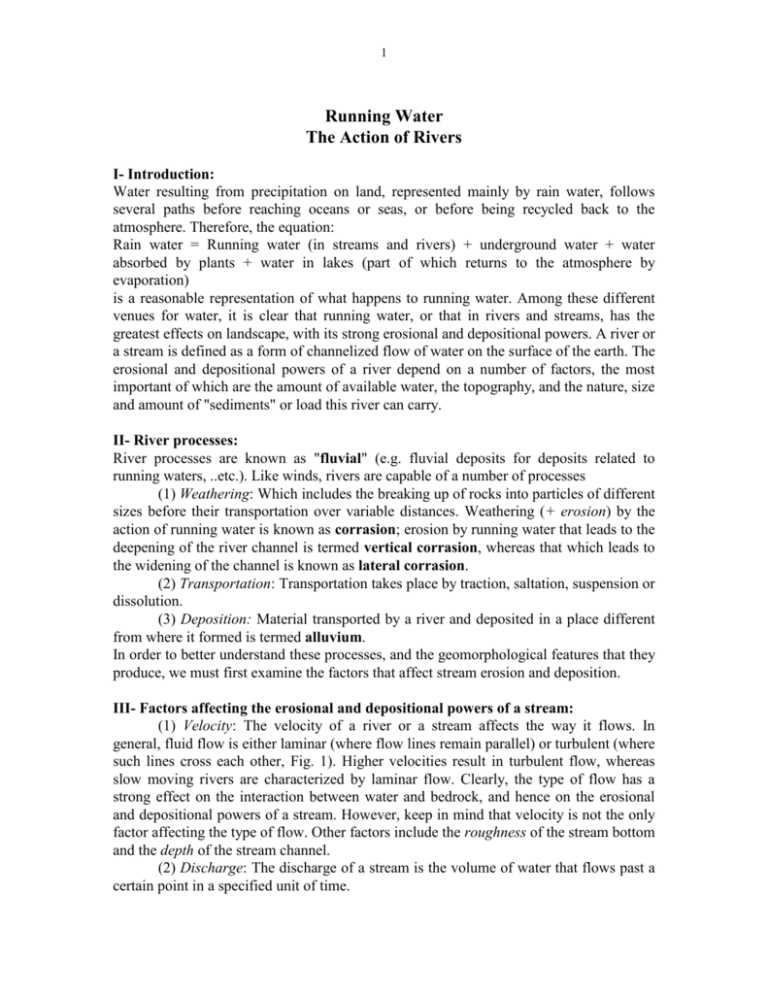
1 Running Water The Action of Rivers I- Introduction: Water resulting from precipitation on land, represented mainly by rain water, follows several paths before reaching oceans or seas, or before being recycled back to the atmosphere. Therefore, the equation: Rain water = Running water (in streams and rivers) + underground water + water absorbed by plants + water in lakes (part of which returns to the atmosphere by evaporation) is a reasonable representation of what happens to running water. Among these different venues for water, it is clear that running water, or that in rivers and streams, has the greatest effects on landscape, with its strong erosional and depositional powers. A river or a stream is defined as a form of channelized flow of water on the surface of the earth. The erosional and depositional powers of a river depend on a number of factors, the most important of which are the amount of available water, the topography, and the nature, size and amount of "sediments" or load this river can carry. II- River processes: River processes are known as "fluvial" (e.g. fluvial deposits for deposits related to running waters, ..etc.). Like winds, rivers are capable of a number of processes (1) Weathering: Which includes the breaking up of rocks into particles of different sizes before their transportation over variable distances. Weathering (+ erosion) by the action of running water is known as corrasion; erosion by running water that leads to the deepening of the river channel is termed vertical corrasion, whereas that which leads to the widening of the channel is known as lateral corrasion. (2) Transportation: Transportation takes place by traction, saltation, suspension or dissolution. (3) Deposition: Material transported by a river and deposited in a place different from where it formed is termed alluvium. In order to better understand these processes, and the geomorphological features that they produce, we must first examine the factors that affect stream erosion and deposition. III- Factors affecting the erosional and depositional powers of a stream: (1) Velocity: The velocity of a river or a stream affects the way it flows. In general, fluid flow is either laminar (where flow lines remain parallel) or turbulent (where such lines cross each other, Fig. 1). Higher velocities result in turbulent flow, whereas slow moving rivers are characterized by laminar flow. Clearly, the type of flow has a strong effect on the interaction between water and bedrock, and hence on the erosional and depositional powers of a stream. However, keep in mind that velocity is not the only factor affecting the type of flow. Other factors include the roughness of the stream bottom and the depth of the stream channel. (2) Discharge: The discharge of a stream is the volume of water that flows past a certain point in a specified unit of time. 2 Discharge (m3/second) = Cross-sectional area of stream (m2) x Stream velocity (m/sec.) The discharge controls the nature and amount of load of a stream; a stream with a large discharge can carry a greater amount of particles, as well as larger-sized particles compared to a stream with a low discharge. Discharge affects the competence and capacity of a stream. Competence is the ability of a stream to carry large particles, whereas capacity is a measure of the number of particles that a stream can carry (Fig. 2). (3) Size and shape of the channel: Streams with narrow channels that are Vshaped in cross section are those in which erosion prevails, whereas those characterized by wider channels that are U- shaped in cross section are ones with a significant amount of deposits. (4) Stream gradient: One of the most important factors. Steep gradients result in fast flowing streams with strong erosional capabilities, whereas gentle gradients result in slower streams which may have depositional features. IV- Types of river load: Rivers carry particles in a number of ways, many of which are similar to the transporting processes of wind. Accordingly, river load is of three types: (i) Load in solution: which includes dissolved salts, the most impotant of which are CaCO3, MgCO3, NaCl, KCl and CaSO4. (ii) Suspended load: Clay and silt sized particles carried by the flowing water through the action of water eddies. Such eddies result from the slower water velocities closer to the stream floors than in the center of the channel. (ii) Bed load: Which includes particles moving downstream by saltation or traction. Figure 3 shows some of these modes of particle movement. V- The Longitudinal profile of a river: Rivers flow from higher altitudes to lower levels. At higher altitudes, rivers or streams receive their supply of water from rainfall. Such areas are known as the headwaters of a river, and are characterized by steeper gradients that allow the streams to flow more rapidly. As the water flows downhill, it erodes the bedrock both vertically and laterally, deepening and widening its channel. Such a process is an attempt by the river to erode an area with a high elevation down to the lowest elevation to which the river flows1. This low elevation is known as the base level of erosion. The ultimate base level of erosion is sea level, but there may be one or more local base levels represented by an inland lake, or an artificial lake created by constructing a dam. Figure 4, a longitudinal profile of a river, shows the effects of building a dam on the change of its base level of erosion. The place where the river flows into the sea or ocean, dumping all its load, is known as the "mouth" of that river. This brief discussion shows that rivers generally have a concave upward longitudinal profile. If such a profile is smooth (i.e. with no disruptions by tectonic activity, change in sea level, ... etc.), the stream then has the right velocities 1In the meantime, deposition in the ocean or sea is an attempt to fill that "basin" of water with sediments so that it reaches the level of land. At that point, when "equilibrium" is maintained with all mountains eroded, and all seas filled, erosion and deposition cease. Naturally, such an "equilibrium" will never be attained, as isostasy acts in such a way that erosion is followed by uplift (isostatic rebound), and deposition by subsidence. Thus the battle between erosion and deposition continues!! 3 everywhere that it is eventually capable of transporting the rock waste supplied to it. Such a stream is then described as a graded stream. A quick examination of the longitudinal profile of a river reveals that such a river evolves through three main stages: (1) an early stage where the gradient is steep, and where erosion by the river prevails over its depositional powers, (2) an intermediate stage, where the river begins to erode laterally, widening its channel and at the same time depositing material, thus maintaining some kind of equilibrium between erosion and deposition, and (3) a late stage close to the river's mouth, where the gradient becomes shallow, the river loses its energy, thus depositing most or all of its load. These three stages are known as Youth, Maturity and Old age, respectively. Although these can indeed be perceived as stages of evolution of a river, every river posseses all three "stages" at the same time in different places! Moreover, part of a river in its mature or old age stages may be "rejuvenated" to the youth stage by uplift or tectonic movements! Because each of these three stages has its own depositional and erosional features, they will be discussed separately. VI- Erosional and Depositional features of Rivers: A- The Youth stage: The youth stage is one in which vertical corrasion prevails over lateral corrasion, thus resulting in an overall deepening of the river channel. The most important erosional features of this stage include: (1) Potholes: Are deep rounded or elliptical grooves in the river bed. These develop when the flowing water "plucks" out fragments and debris from the bedrock where such rock is weaker (i.e. along planes of weakness as joints, faults or bedding planes). The bed load and the suspended load then act on such a groove by abrasion, deepening and enlarging it. Some particles belonging to this bed load may then fall into these potholes (Fig. 5). (2) Cataracts (rapids): Result from the differential erosion of the bedrock along the river channel, where soft layers are eroded more easily than hard ones. As the harder layers remain, often sticking out as little "islands" in the middle of the river, the gradient of that river becomes locally steeper, and the river flows faster (Fig. 6). (3) Waterfalls: Result from the differential erosion of a series of horizontal (or nearly horizontal) layers. When an outcrop of resistant rock is underlain downstream by a weaker layer, the latter is more easily eroded, leaving the overlying resistant layer "sticking out" and forming a steep ledge. A small ledge forms rapids, but once the resistant face becomes vertical, the stream water plunges over the newly formed cliff to form a waterfall. If the units dip gently in the upstream direction, continued upstream erosion may then form a new set of 4 rapids. Figures 7 and 8 show the stages of evolution of a waterfall and its relationship to rapids. (4) Captured or pirated streams: Commonly, an area may have two streams flowing in different directions, and separated by a land mass known as a "continental divide". If those two streams are at different stages in their erosional cycle, (i.e. one is more youthful than the other), then the more youthful will erode upstream at a faster rate, decreasing the area of that continental divide. Eventually, the youthful stream reaches the channel of the more mature (or less eroding) stream through continued erosion, and ends up diverting its waters to its own channel, leaving the channel of the more mature stream dry. This process is known as river capture or river piracy. Figures 9a & b show the stages of river capture. B- Mature Stage: The mature stage of evolution of a river is characterized by some sort of a balance between erosion and deposition, where the gradient generally becomes shallower compared to the youth stage. Mature streams are also characterized by lateral corrasion and widening of the river channel, rather than the vertical erosion or downcutting which characterize the youth stage. This widening may be viewed as the result of several tributaries of the youth stage joining each other into one channel. During this stage, stream water, taking the least resistant path, may develop a winding channel (known as a meander, see below), with deposition taking place on one side of that channel and erosion on the opposite side. As the water level changes seasonally, the energy of the stream changes, and so does its capability to carry its load. When the water level drops, and its energy decreases, the stream drops some of its sediments either in the middle or on one side of its channel, forming a point bar. Figure 10 shows a bar in the middle of a stream channel, and its effect on diverting the flow of such a channel. Note that point bars become more abundant during the old age of a stream where they may cause a stream to become braided (Fig. 10b). C- The Old Age: In this stage, the stream has lost most of its energy, and the gradient becomes gentle. Streams at this stage are characterized by the predominance of depositional features, and the near absence of vertical erosion; erosional processes working mostly towards widening the river channel. Features characteristic of this stage include meanders, flood plains and deltas. (i) Meanders and associated features: 1- Meanders: As the energy of the river decreases during this stage, it attempts to follow the path of least resistance. Accordingly, if the water flowing in this channel meets an obstacle, its channel is deflected slightly to avoid this obstacle. This causes the stream to develop a bend, which in turn disturbs the flow pattern of that river. Under normal conditions, a stream attains its maximum velocity at the center of the channel, but in the presence of an obstacle, the maximum velocity occurs closer to the outer bend of that channel, whereas closest to the obstacle that caused the channel to bend, the stream 5 velocity is lowest (Fig. 11). This causes the stream to erode on the outside of each bend where the decrease of the stream velocity causes the stream to deposit sediments (close to the obstacle) in the form of a point bar (see above; Figs. 10 & 15). Erosion on the outside of the bend results in deepening and widening the stream channel in those areas, forming a cut bank (Fig. 12), whereas deposition on the inside of the bend has the opposite effect, and the stream floor develops a slip off slope close to the point bar (Figs. 12 & 15). The net effect of these two processes is the migration of the river bends to the outside (laterally) as well as dowstream (due to vertical erosion; Figs. 13 & 14). 2- Cutoffs: As the meanders grow laterally, and the loops become longer and longer, and as erosion on the outside bends of a meader continues, the stream may finally choose a shorter straight path known as a "cutoff" (Fig. 14). It should be noted that the formation of a cutoff, which leads to the isolation of part of the former stream into an oxbow lake (Fig. 14), is not an eternal feature, as the river will begin winding again, creating new meanders. 3- Oxbows and oxbow lakes (bayous): An oxbow lake is that portion of the stream that was cut off from the channel (Fig. 14). Such lakes have a characteristic shape, with their concave sides facing the stream channel. When oxbow lakes dry up, they are known as oxbows. 4- Flood plains: Quite often, during the mature and old age stages, and following periods of very heavy and/or continuous rainfall, the discharge of a river increases to a point where the channel can no longer hold all its water. At this point, water rises over the banks of the river, and covers the adjacent low-lying land. This process is known as "flooding", and could be disastrous to human activity or property in such areas. Floods occur periodically, and can be to some extent predicted on statistical basis. The flat areas covered by water during floods are known as the flood plains of the river (Figs. 16 & 18). 5- Natural levees: Each time a flood occurs, sediment is deposited on the flood plain, particularly on the banks of the river. Whereas silt and clay are deposited some distance from the main channel on the flood plain, the coarser load is dropped on the banks of the river, piling up to form natural levees, that are left behind after the flood is over and when the water level drops. These natural levees are then broken each time a new flood occurs. Figure 17 shows the stages of formation of natural levees. 6- River terraces: River terraces develop as a result of "rejuvenation" of a mature or old river, where the gradient of that river suddenly increases due to rapid uplift or some tectonic activity. As a result of this rejuvenation, the river acquires more energy and downcuts its own channel or flood plain by increased vertcial erosion. Repeated rejuvenation results in the formation of several river terraces, the oldest of which is the highest (Fig. 18). When the terraces on both sides of a river channel are of the same elevation, they are termed "paired terraces". Unpaired terraces are those that do not match across the river channel, and form by simultaneous downcutting and lateral erosion. 6 (ii) Deltas: Deltas form when rivers deposit their load in lakes, seas or oceans. However, for deltas to form, the rate of sediment deposition or accumulation has to exceed its rate of removal by waves and currents, otherwise, only an estuary forms at the river mouth. As the river loses its energy, it drops its load, and the coarse-grained particles are deposited on the sloping surface leading to the sea. These deposits grow towards the sea, and the sediments there are deposited as inclined layers known as the foreset beds. Finer-grained sediments are deposited farther away from the shore and deeper in the sea to form the bottomset beds, whereas the thin layer of fine-grained sediments deposited on top of the foreset beds is known as topset beds (Fig. 19). Types of deltas: There are three types of deltas: 1- Arcuate deltas: These form when the river water has about the same density as that of the ocean or sea. Accordingly, the sediments are deposited slowly to form foreset, bottomset and topset beds. Such deltas are usually shaped like an inverted , with the Nile delta being the classical example (Fig. 20). 2- Bird's leg deltas: Form when the river water is less dense than that of the sea or ocean. As a result, the river develops several channels beyond its mouth along which it drops its load, leading to an overall shape similar to that of a bird's leg. It should be noted that these channels, and hence the deltas themselves are constantly modified by the prevailing waves and currents in the ocean or sea. Examples of this type include the Mississippi River delta. 3- Elongated deltas: These form where the river water is denser (because of its load) than the water in the lake, sea, or ocean in which it is flowing. As a result, the river water flows along the bottom of the sea as a turbidity current, depositing sediment in an elongated delta. Figure 20 shows the different types of deltas. (iii) Other features associated with the old age stage: 1- Alluvial fans: When a stream experiences a sudden change in its gradient, such as across a fault scarp, it loses its energy and deposits its load at that point, forming a conical fan shaped accumulation of sediments or alluvial deposits. 2- Braided streams: These develop on flood plains where large amounts of debris are deposited, obstructing the flow of water and causing the stream to develop a large number of entangled and crossing channels (Fig. 10). 7 VII- Drainage Patterns: The overall pattern developed by a system of streams and tributaries depends on the nature of the underlying rocks, major structures in the area, and the history of the stream. There are four major drainage patterns: 1- Dendritic: Is a pattern that develops when the underlying bedrock is uniform in its resistance to erosion, and has no control over the direction of valley growth. 2- Radial: A radial pattern is one in which the streams and their valleys radiate outwards and dowwards from a central high area. This pattern develops around volcanic cones. 3- Rectangular: A rectangular pattern occurs when the underlying bedrock is jointed or fractured. These fractures are lines or planes of weakness along which the water channels form. 4- Trellis: A trellis pattern develops when the river is underlain by rocks of different resistance to weathering. The elongate tributaries that are parallel to each other but run perpendicular to the main river channel are often the result of folding and differential erosion (Fig. 21).
